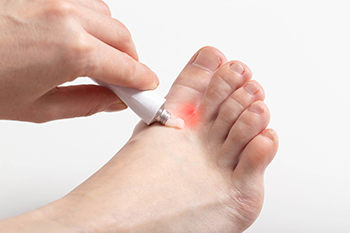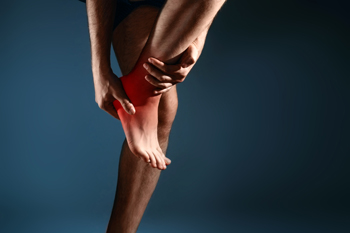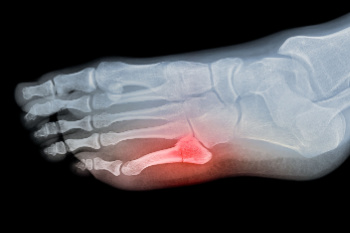Items filtered by date: July 2025
Facts About Bunion Surgery

Bunion surgery is a corrective procedure used to realign the bones and soft tissue surrounding the big toe joint when a bunion causes pain or interferes with daily activities. It may be recommended when non-surgical treatments no longer relieve discomfort or when the bunion worsens over time. The procedure involves removing the bony bump and adjusting the affected joint to restore normal alignment. Common reasons to have bunion surgery include chronic pain, swelling, difficulty wearing shoes, and reduced mobility. A podiatrist will evaluate your foot, discuss options, and guide your recovery for the best outcome. If bunion pain affects your quality of life, it is suggested that you consult a podiatrist to see if surgery is the right solution for you.
Foot surgery is sometimes necessary to treat a foot ailment. To learn more, contact Vrunda Dalal, DPM of Sole Focus Foot and Ankle. our doctor will assist you with all of your foot and ankle needs.
When Is Surgery Necessary?
Foot and ankle surgery is generally reserved for cases in which less invasive, conservative procedures have failed to alleviate the problem. Some of the cases in which surgery may be necessary include:
- Removing foot deformities like bunions and bone spurs
- Severe arthritis that has caused bone issues
- Cosmetic reconstruction
What Types of Surgery Are There?
The type of surgery you receive will depend on the nature of the problem you have. Some of the possible surgeries include:
- Bunionectomy for painful bunions
- Surgical fusion for realignment of bones
- Neuropathy decompression surgery to treat nerve damage
Benefits of Surgery
Although surgery is usually a last resort, it can provide more complete pain relief compared to non-surgical methods and may allow you to finally resume full activity.
Surgical techniques have also become increasingly sophisticated. Techniques like endoscopic surgery allow for smaller incisions and faster recovery times.
If you have any questions, please feel free to contact our office located in Marlton, NJ . We offer the newest diagnostic and treatment technologies for all your foot care needs.
How a Podiatrist Can Help Conquer Athlete’s Foot

Athlete’s foot is a common fungal infection that affects the skin on the feet, often appearing between the toes. It is caused by fungi that thrive in warm, moist environments such as locker rooms, showers, or sweaty footwear. Symptoms include itching, burning, redness, peeling, and cracked skin. Risk factors include wearing tight shoes, poor foot hygiene, and frequenting public places barefoot. A podiatrist can diagnose the condition, recommend antifungal treatments, and offer guidance to prevent recurrence. Proper foot care and early treatment are key to avoiding complications or spreading the infection. If you notice persistent foot irritation or signs of athlete’s foot, it is suggested that you visit a podiatrist for effective care and lasting relief.
Athlete’s foot is an inconvenient condition that can be easily reduced with the proper treatment. If you have any concerns about your feet and ankles, contact Vrunda Dalal, DPM from Sole Focus Foot and Ankle. our doctor will treat your foot and ankle needs.
Athlete’s Foot: The Sole Story
Athlete's foot, also known as tinea pedis, can be an extremely contagious foot infection. It is commonly contracted in public changing areas and bathrooms, dormitory style living quarters, around locker rooms and public swimming pools, or anywhere your feet often come into contact with other people.
Solutions to Combat Athlete’s Foot
- Hydrate your feet by using lotion
- Exfoliate
- Buff off nails
- Use of anti-fungal products
- Examine your feet and visit your doctor if any suspicious blisters or cuts develop
Athlete’s foot can cause many irritating symptoms such as dry and flaking skin, itching, and redness. Some more severe symptoms can include bleeding and cracked skin, intense itching and burning, and even pain when walking. In the worst cases, Athlete’s foot can cause blistering as well. Speak to your podiatrist for a better understanding of the different causes of Athlete’s foot, as well as help in determining which treatment options are best for you.
If you have any questions please feel free to contact our office located in Marlton, NJ . We offer the newest diagnostic and treatment technologies for all your foot and ankle needs.
Heel Pain in the Morning?
What You Should Know About Heel Pain

Heel pain is one of the most common foot complaints and can stem from a variety of causes. One frequent source is strain on the tissue that runs along the bottom of the foot, which can lead to soreness near the heel, especially in the morning or after periods of rest. Other possible causes include inflammation of the heel’s growth plate, irritation of surrounding tendons, or pressure from improper footwear. Sometimes the pain may come on gradually, while in other cases it may feel sharp and sudden. Activity level, foot shape, and age can all influence the risk of developing heel pain. Addressing the problem early often helps prevent it from becoming a long-term issue. If your heel continues to hurt or affects how you walk, it is suggested that you see a podiatrist to determine the cause and find the most effective solution.
Many people suffer from bouts of heel pain. For more information, contact Vrunda Dalal, DPM of Sole Focus Foot and Ankle. our doctor can provide the care you need to keep you pain-free and on your feet.
Causes of Heel Pain
Heel pain is often associated with plantar fasciitis. The plantar fascia is a band of tissues that extends along the bottom of the foot. A rip or tear in this ligament can cause inflammation of the tissue.
Achilles tendonitis is another cause of heel pain. Inflammation of the Achilles tendon will cause pain from fractures and muscle tearing. Lack of flexibility is also another symptom.
Heel spurs are another cause of pain. When the tissues of the plantar fascia undergo a great deal of stress, it can lead to ligament separation from the heel bone, causing heel spurs.
Why Might Heel Pain Occur?
- Wearing ill-fitting shoes
- Wearing non-supportive shoes
- Weight change
- Excessive running
Treatments
Heel pain should be treated as soon as possible for immediate results. Keeping your feet in a stress-free environment will help. If you suffer from Achilles tendonitis or plantar fasciitis, applying ice will reduce the swelling. Stretching before an exercise like running will help the muscles. Using all these tips will help make heel pain a condition of the past.
If you have any questions, please feel free to contact our office located in Marlton, NJ . We offer the newest diagnostic and treatment technologies for all your foot care needs.
Heel Spurs and Finding Relief Through Exercise

A heel spur is a calcium deposit that causes a bony protrusion on the underside of the heel bone, often linked to plantar fasciitis. It can lead to sharp pain, especially with the first steps after rest. Gentle exercises such as calf stretches, towel stretches, and rolling the foot over a cold bottle can help ease discomfort by loosening the plantar fascia and surrounding muscles. Consistent stretching may improve flexibility and reduce strain on the heel. A podiatrist can provide an accurate diagnosis, recommend targeted treatment, and give you exercises appropriate for your condition. If heel pain is limiting your movement, it is suggested that you consult a podiatrist for a personalized plan to support healing and long-term relief.
Stretching the feet is a great way to prevent injuries. If you have any concerns with your feet consult with Vrunda Dalal, DPM from Sole Focus Foot and Ankle. our doctor will assess your condition and provide you with quality foot and ankle treatment.
Stretching the Feet
Stretching the muscles in the foot is an important part in any physical activity. Feet that are tight can lead to less flexibility and make you more prone to injury. One of the most common forms of foot pain, plantar fasciitis, can be stretched out to help ease the pain. Stretching can not only ease pain from plantar fasciitis but also prevent it as well. However, it is important to see a podiatrist first if stretching is right for you. Podiatrists can also recommend other ways to stretch your feet. Once you know whether stretching is right for you, here are some excellent stretches you can do.
- Using a foam roller or any cylindrical object (a water bottle or soda can will do), roll the object under your foot back and forth. You should also exert pressure on the object. Be sure to do this to both feet for a minute. Do this exercise three times each.
- Similar to the previous one, take a ball, such as a tennis ball, and roll it under your foot while seated and exert pressure on it.
- Grab a resistance band or towel and take a seat. If you are using a towel, fold it length wise. Next put either one between the ball of your foot and heel and pull with both hands on each side towards you. Hold this for 15 seconds and then switch feet. Do this three times for each foot.
- Finally hold your big toe while crossing one leg over the other. Pull the toe towards you and hold for 15 seconds. Once again do this three times per foot.
It is best to go easy when first stretching your foot and work your way up. If your foot starts hurting, stop exercising and ice and rest the foot. It is advised to then see a podiatrist for help.
If you have any questions please contact our office located in Marlton, NJ . We offer the newest diagnostic and treatment technologies for all your foot and ankle needs.
Identifying a Toe Fracture

A toe fracture is a break in one of the small bones of the toe, often caused by trauma such as stubbing the toe, dropping something heavy on it, or sports injuries. Symptoms include pain, swelling, bruising, and difficulty walking. The affected toe may appear crooked or misaligned. Diagnosis typically involves a physical examination and imaging tests like X-rays to confirm the extent and location of the break. A podiatrist can assess the injury and recommend appropriate care, which may include splinting, protective footwear, or, in some cases, surgery. If you suspect a broken toe, it is suggested that you visit a podiatrist promptly to ensure proper healing and to avoid long-term complications.
A broken toe can be very painful and lead to complications if not properly fixed. If you have any concerns about your feet, contact Vrunda Dalal, DPM from Sole Focus Foot and Ankle. our doctor will treat your foot and ankle needs.
What to Know About a Broken Toe
Although most people try to avoid foot trauma such as banging, stubbing, or dropping heavy objects on their feet, the unfortunate fact is that it is a common occurrence. Given the fact that toes are positioned in front of the feet, they typically sustain the brunt of such trauma. When trauma occurs to a toe, the result can be a painful break (fracture).
Symptoms of a Broken Toe
- Throbbing pain
- Swelling
- Bruising on the skin and toenail
- The inability to move the toe
- Toe appears crooked or disfigured
- Tingling or numbness in the toe
Generally, it is best to stay off of the injured toe with the affected foot elevated.
Severe toe fractures may be treated with a splint, cast, and in some cases, minor surgery. Due to its position and the pressure it endures with daily activity, future complications can occur if the big toe is not properly treated.
If you have any questions, please feel free to contact our office located in Marlton, NJ . We offer the newest diagnostic and treatment technologies for all your foot care needs.


